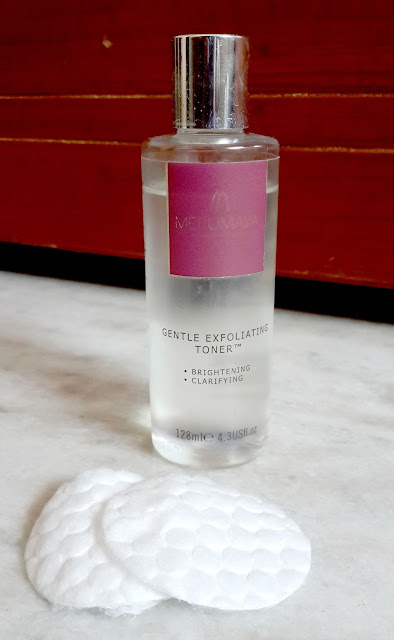In my previous post, I spoke about the Clinique Mild Clarifying Lotion and what it did and did not do for my skin. Continuing with my toner review series, today, I want to talk about one of my favourite exfoliating toners. Tada!
MERUMAYA GENTLE EXFOLIATING TONER
In case you're new to exfoliating toners, here's a quick note on why they are useful. Exfoliating toners are called so because they contain exfoliating acids such as salicylic acid, lactic acid, glycolic acid, etc.
Exfoliating toners:
1) Lower the ph of the skin so that when a harsh cleanser is used on the skin, raising its ph value from a natural, healthy level of 5 to anywhere beyond level 6-7, the exfoliating acid brings down the ph back to its healthy level. A healthy ph level means that bad bacteria do not breed on the skin, thus reducing instances of acne.
2) Wipe away dead skin cells, which ordinary toners are not capable of. Removal of dead skin cells means the fresher skin cells underneath are more capable of taking in whatever skincare products you use next. In short, without exfoliation, you're just moisturising dead skin cells.
3) Tend to make the skin sensitive if they are overused. The visible results they give can tempt you to overuse them.
Why I purchased it
Merumaya came into my radar when I was researching into cleansing balms, which is a separate blog post in itself. Once on the Merumaya website, I noticed how passionately its creator, Maleka Dattu, described each product that she offered--the inspiration behind it, the need for it, the active ingredients, etc. And before I knew it, the product fell into my cart. Also, it helped to know that Maleka had Caroline Hirons' blog readers test out this product during the pre-manufacture phase. Caroline, being a proponent of exfoliating toners, asked her readers to test it out as most of them were used to exfoliating acids and obviously had high standards of a new exfoliating product. Long story short, the toner met their approval.
Ingredients:
Aqua (Water), Glycerin, Citric Acid, Tartaric Acid, Polysorbate 20, Sodium Hydroxide, Betaine, Hamamelis Virginiana (Witch Hazel) Leaf Extract, Lactic Acid, Maris Aqua, Chlorella Vulgaris Extract, Sodium Hyaluronate, Hydrolyzed Algin, Parfum (Fragrance), Disodium EDTA, Phenoxyethanol, Limonene, Potassium Sorbate, Sodium Benzoate, Cellulose Gum, Ethylhexylglycerin, Citronellol, Linalool, Geraniol, Benzyl Alcohol, Isoeugenol, Benzyl Benzoate
How much acid is in it?
The toner contains 15 per cent of ‘Natural AHA (Alpha Hydroxy Acids) Complex’, which is the maximum permitted level of that ingredient and equates 10 per cent actual AHAs. From what I understand, this toner has a good percentage of lactic acid, citric acid and tartaric acid, although the latter two are also used as ph adjusters (to ensure the product isn't too acidic or basic), so I'm not sure about the concentration of each acid. But lactic acid, on its own, is a wonderful gentle exfoliant, which explains the name of the product.
Generally speaking, AHAs, like glycolic acid, are considered harsh, but Maleka says that if the product formulation is right, the harshness or the sting that acids give can be buffed. For this, she has included Hyaluronic Acid (for moisture and hydration), Betaine (an anti-irritant) and Glycerin in the toner.
Now for the test of any exfoliating product--out come the ph strips. As mentioned in my previous post, this toner records a solid 3 on the ph scale, making it perfect for exfoliation. In case you missed that post, here's the comparison shot with the Clinique toner. As you can see, the Merumaya patch is a bright yellow, indicating its acidic ph level.
Packaging and user experience
The toner's packaging is faultless. It comes in a 128 ml see-through plastic bottle. The lid is a press-down type, which is extremely convenient.
The first thing you notice on using this toner is that phenomenal Merumaya signature scent, which Maleka likes to include in all her products. So, while the toner and the cotton pad are buffing away dead skin cells on your face and neck, you can breathe in this lovely aroma. I'm not particularly good at describing fragrances but if I had to, I'd say that this has a light floral, spa-like scent.
Price and where to buy
The toner is priced at 15 GBP, which translates to 1200 INR. I know this is pricey as per Indian standards but there are hardly any exfoliating toners being sold in India. I can only think of Plum and its glycolic acid-based toner.
As far as buying Merumaya products is concerned, obviously, they can be purchased from the Merumaya website but the shipping fee to India is 15 GBP, which is extortionate. So, I didn't buy it immediately. I searched high and low for other sites that sold Merumaya products internationally. No luck! Eventually, I bit the bullet and placed a huge order to qualify for free shipping. Works out well, that way. On the one hand, I'm happy that Merumaya ships globally but I seriously hope that she and her team consider doing something about that horrendous shipping fee.
Worth the hype?
The Merumaya Gentle Exfoliating Toner is completely worth the hype. It is formulated at the right ph, does not sting the skin and is convenient as well as pleasurable to use. I highly recommend it if you don't mind the splurge, shipping fee included.
In my next post, I will talk about the Bravura Detoxifying Eucalyptus Astringent Toner with 15% AHA/BHA. Stay tuned!















